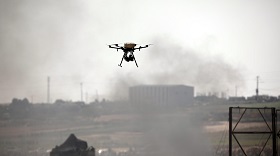At the beginning of its era, the practice of targeted killing lacked the necessary legal framework. However, after the U.S. joined the game after the events of 9/11, the international community saw the broad argumentation in favor of targeted killings — even though in July 2001 the U.S. stood against the intentional killing operations of individuals beyond the scope of armed conflicts. Today, with targeted killings’ fulminant spread, and the overwhelming divergence between drone and strike aircraft costs, the issue of a legal framework UAV-executed targeted killings is a pertinent research subject.
Existent legitimation of targeted killing and drone use employs enervate argumentation: despite this, it is globally promoted. This contradiction exists because the nations that have invested in said technologies wish to exploit them beyond their legally defined limits.
While the practice of targeted killing is not losing its popularity and drones proliferation and modernization is happening at high pace, the legal framework of such strikes stays unclear and enervate on both levels of just war: ad bellum and in bello. It all starts with the weak argumentation that targeted killing is not equal to assassination as this practice takes place in the context of war. As proved before, it is questionable whether it is a war with a just reason. The humanitarian law rationalization and the entire was-status debate seem to suffer much criticism, especially in the era of drones as the new actors of the warfare. This paper proves, however, that the vagueness and weakness described are not accidental: states exploit them in order to expand their power, uplift their status in the international hierarchy and compete in the quite wealthy drones market.
At the beginning of its era, the practice of targeted killing lacked the necessary legal framework. However, after the U.S. joined the game after the events of 9/11, the international community saw the broad argumentation in favor of targeted killings — even though in July 2001 the U.S. stood against the intentional killing operations of individuals beyond the scope of armed conflicts. Today, with targeted killings’ fulminant spread, and the overwhelming divergence between drone and strike aircraft costs, the issue of a legal framework UAV-executed targeted killings is a pertinent research subject.
Existent legitimation of targeted killing and drone use employs enervate argumentation: despite this, it is globally promoted. This contradiction exists because the nations that have invested in said technologies wish to exploit them beyond their legally defined limits.
Jus ad bellum limitations of targeted killings
The essential claim of the originally US argumentation developed by Obama’s administration is that targeted killing does not constitute the unlawful practice of assassination as the former only takes place during an armed conflict. In the US case, that armed conflict is supposedly the declared ‘War on Terror’. Legally, the act of ‘Authorization for use of military force’ legitimized U.S. force against terrorists as a self-defense response to an armed attack. Thus, the U.S. claims that it can invoke the right to use force expressed in Article 51 of the UN Charter. 9/11 is understood as an armed attack, and thus response to it in the form of targeted killings fits another demand of international law — proportionality — decreasing collateral damage to the irreducible minimum, particularly with the application of drones technologies.
Here, one faces several statements that are far from obvious. First of all, is the global “war on terror” or “the forever war” or, as it was named by Foreign Affairs, “the never-ending war”, indeed a war? Critical experts are divided into two camps. Some, like Andrew Orr, claim that the “war on terror” does not rise to the level of armed conflict. Others argue that, while there may be a legitimate war on terror, the US government has used the same legal explanation for strikes beyond the scope of this war, as happened in Pakistan. Thus, invoking “war” allows the U.S. and its allies to exploit the term’s legal (jus in bello) attributes, a point which will be expanded upon below.
Secondly, even if the war on terror is a war, responding to 9/11 is clearly not its objective. Aggression, again, in strict terms, is a state prerogative. However, even in the contemporary multi-actor world where one can imagine a juridical act of aggression from a terrorist group, legal scholars do not forget the criteria of self-defense — necessary and proportionate. In this case, the new wave of Obama administration drone attacks in response to the tragic events of 2001 does not seem to match either, although both concepts are too vague to measure and, thus, easy to manipulate.
This context prompts a theoretical question: does a “statute of limitations” exist for military responses to armed aggression? If one exists, the international community has evident difficulties defining its expiration, while if not, appealing to historical precedent would restrict this statute to territorial issues.
Moreover, theorists of realism would automatically notice that this argumentation does not consider the major issue of state sovereignty — the keystone of contemporary international relations. One example is when the Pakistani government invited the USA to execute drone strikes within its territory [1]. However, when there is no legal invitation for drone-based violations of state sovereignty, could this transgression still be legitimate? Such military decisions promote the abrogation of Westphalian sovereignty and, therefore, discredit extant legal norms.
Thus, a self-defense response to 9/11 is employed as a blanket excuse to exercise power in peacetime, expanding the notion of war, and restricting that of sovereignty.
Status debate and the concept of Just War
According to the original argumentation, 9/11 demands a response in the form of targeted killing. In the context of this ‘armed conflict,’ Al Qaeda fighters are claimed to be combatants and, thus, the ultimate rule of free kill is applicable to them in full accordance to jus in bello. Interestingly enough, according to the memorandum by John Yoo and Robert J. Delahunty that explains the legal framework applicable to the war in Afghanistan and ‘the war on terror’ in general, Al Qaeda fighters are excluded from jus in bello protections. However, this situation seems suspiciously advantageous to the U.S. government. It can wage war against an actor exclusively comprised of unlawful combatants, and therefore absent Geneva convention protections. Thus, we both return to the issue of combatant inequality, while encountering the new question of terrorist combatant status.
It is impossible to avoid the problem of drones’ actorness and, therefore, combatant-status. The issue is that artificial intelligence algorithms are constantly updated and used in drone attacks. Said strikes are often criticized for collateral damage rates and general imprecision: between 2004 and 2011 the percentage of civilians killed due to mistakes made by drone operators — in their intelligence or strikes themselves — was about 20% in Pakistan. AI has and will continue to, increase the precision and decrease the collateral damage of drone strikes. However, by making drones fully autonomous, they are transformed from weapons or vehicles to become ontological actors in warfare.
This would be irrelevant without the multi-century global awareness of just war theory. However, thanks to philosophical heritage, we know that a legitimate combatant not only has the right to kill military adversaries during operations but also must be prepared to be killed in kind. Drones eliminate this condition. They feel neither fear, pain, nor remorse — no proportionality can exist with a machine. What was once warfare becomes a hunt.
Another aspect of drone warfare appears to be quite provocative: military forces and intelligence organizations both use drones. While the U.S. Army’s soldiers are undoubtedly paradigmatic cases of lawful combatants — with their clearly displayed uniforms and weapons — the CIA’s assets, as intelligence operatives, necessarily fall outside this classification. Nevertheless, the CIA, alongside U.S. Special Operations Forces, is the core tool in the US’ counterterrorism strategy. Hence, their use of drones in conflict and non-conflict zones is evidently problematic. In line with Albert Camus’ famous statement, a fighter must be visible in order to give their opponent an opportunity to defend. Moreover, as intelligence participates in the armed conflict, legally speaking, CIA agents can be lawfully killed even on the territory of the United States.
Benefiters
It can then be asked if the issue is so problematic in its legal and ethical bases, what is the reason for targeted killings’ precipitous popularization? In 2016 Sarah E. Kreps and Geoffrey Wallace published an article “International law, military effectiveness and public support for drone strikes” in the Journal of Peace Research [2]. Their analysis is devoted to the drones warfare assessment by three different actors: the U.S. government, international organizations (primarily — the UN) and non-governmental organizations. The only actor that was pro-drone strikes, considering the three debatable issues the study employed — sovereignty, civilian issues frame, and effectiveness — was the U.S. government. The practice is inseparable from a specific favorable political narrative.
From this, we arrive at the idea that the political establishment of the countries that carry out active drone policies are drawn to this policy tool despite all its widely discussed legal and ethical complications — hence, this requires analysis.
The first explanation comes from the Marxist paradigm. In April 2018, the military drone market was assessed as $83 billion. Major producers like the US companies General Atomics, Northrop Grumman, Textron, and Boeing have retained their economic dominance. Interestingly, by June 2017, General Atomics was the only enterprise capable of producing large military drones. However, they have now encountered competition from Chinese firms, whose CASC Rainbows are widely used in Nigeria, for instance. Similar competitive pressures with Israeli firms like IAI, Rafael, and Elbit has pushed Donald Trump to ease the regulations over military drones export. Thus, first, promotion of the drones-positive agenda is a matter of commercial interest.
However, national interests do not stop there. Like any advanced weapon, drones have become a tool to demonstrate international political power and military sophistication. The hysteric titles of US authoritative magazines fully demonstrate the level of disquietude: “China Has Already Won the Drone War” in Foreign Policy or “Russia’s Next Deadly Weapon: A Stealth, Jet-Powered Robot Warplane” in The National Interest. Ironically, military capabilities are thereby transformed into politico-psychological tools.
The final point concerns a more philosophical problem of a state’s nature. Drones, targeted killings, and the legal vacuum surrounding them creates an opportunity to expand violence and, thus, power without regarding the basic principles of state sovereignty. Applying Thomas Hobbes’ philosophical paradigm of states’ unitary, aggressive nature, the state is naturally encouraged to perpetuate warfare. In the case of drones, the timeless war becomes even more intense due to the gap between countries’ UAV’s capabilities. As the proverb goes, Homo Homini Lupus est — the great shall hunt the small.
Broadly speaking, states, owning and producing drones and frequently appearing to be regional hegemons, are the most invested in drone policy. Not only do they benefit financially — whilst the economy of drones becomes a field of international competition — but they also receive an opportunity to demonstrate their power and exercise it in the context of expanding warfare and, therefore, violence as such.
***
While the practice of targeted killing is not losing its popularity and drones proliferation and modernization is happening at high pace, the legal framework of such strikes stays unclear and enervate on both levels of just war: ad bellum and in bello. It all starts with the weak argumentation that targeted killing is not equal to assassination as this practice takes place in the context of war. As proved before, it is questionable whether it is a war with a just reason. The humanitarian law rationalization and the entire was-status debate seem to suffer much criticism, especially in the era of drones as the new actors of the warfare. This paper proves, however, that the vagueness and weakness described are not accidental: states exploit them in order to expand their power, uplift their status in the international hierarchy and compete in the quite wealthy drones market.
References:
1. Gunneflo M. Targeted Killing — Cambridge, 2016, 268.
2. Kreps S. E., Wallace G. International law, military effectiveness and public support for drone strikes // Journal of Peace Research, 2016, 53, 6, 830 — 844.







